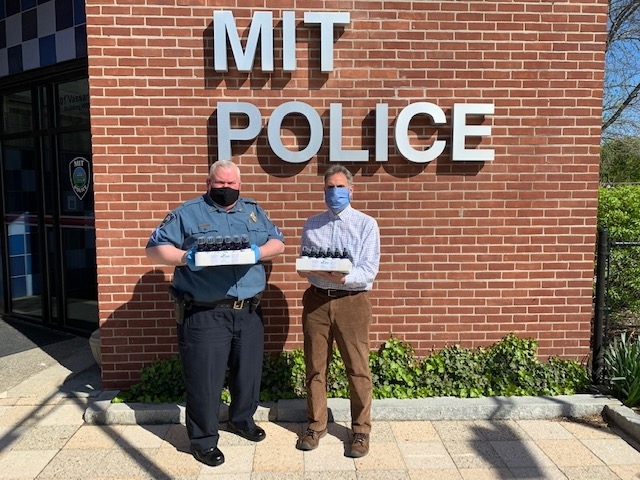When MIT's Environment, Health and Safety Office (EHS) obtained a publication from the World Health Organization (WHO) describing the recommended formula for creating hand sanitizer, it decided to take action. Like campuses and institutions around the country, MIT has experienced a severe shortage of hand sanitizer, putting front-line workers at especially high risk for Covid-19.
MIT EHS is accustomed to identifying problems and exercising leadership and initiative to find creative solutions, and the hand sanitizer shortage has been no exception. “We thought, let’s run a pilot, and see if we can come up with something that is useful for the MIT community,” says Tolga Durak, managing director of EHS programs. To spearhead the project, Durak turned to Bob Edwards, an associate director in EHS, and his team.
After experimenting with several different formulations for hand sanitizer, they settled on the formula suggested by the WHO and the U.S. Food and Drug Administration (FDA), even though the consistency is different from some of the commercial formulations that result in the more typical gel form.
Because MIT EHS has the laboratory capabilities and technical expertise to undertake a project like this one, Edwards and the laboratory staff quickly began mixing and testing, following the WHO guidelines. The process was far from simple. The first few experimental batches came out too watery and sticky, but the team continued refining the formula and testing with EHS staff for viscosity and efficacy. They soon arrived at the right mixture and began scaling up production.
Once the formula was perfected, the EHS communications and IT team sprang into action with an attractive label design, and sourced precisely the right kind of smudge-proof color label materials to package the hand sanitizer. The communications and IT teams also aptly named the product “Everyday Hand Sanitizer” (EHS) to share an acronym with the department that created it.
With the target concentration of 80 percent ethanol as the active ingredient, along with glycerol, hydrogen peroxide, and deionized water, each batch is tested for alcohol content before distribution. The alcohol content level exceeds the U.S. Centers for Disease Control and Prevention recommended minimum amount of 60 percent to deactivate Covid-19 and other viruses. However, it's important to remember that hand sanitizer is not a substitute for hand washing, and should only be used when soap and water are not available.
The EHS team found that the most effective distribution method was individual 4-ounce spray bottles, which have so far been distributed to MIT Police, MIT Custodial Services, and MIT’s student-run Emergency Medical Services team.
“While this is not a commercial product and we are not selling it, what we’ve been able to produce, thanks to EHS’ technical capabilities and expertise, is fully viable, FDA-registered and listed product comparable to the most effective sanitizer products on the market,” says Durak. “I’m proud of the EHS team for rising quickly to the challenge of campus need.”
For MIT EMS, hand sanitizer is a key tool in regular operations. “Hand sanitizer is an indispensable component of keeping EMTs — and therefore our patients — safe,” says Lawrence Wong, MIT aeronautics and astronautics graduate student and volunteer EMT. “In just doffing alone, we perform hand hygiene after each PPE item is removed, and we go through a tremendous volume of hand sanitizer. The hand sanitizer produced by EHS has assured our operational readiness amidst supply challenges. Their choice of packaging also makes it very portable and accessible for EMTs.”
Sergeant David J. O’Connor of the MIT Police department says the individual bottles of hand sanitizer “could not have come at a better time,” as he and his fellow officers work to keep the campus safe. “This generous donation from EHS allows every officer to have their own personal bottle of hand sanitizer to carry with them throughout their shift,” says O’Connor. “The MIT Police department owes a great debt of gratitude to the EHS Office for their efforts to keep the members of our department and our community safe.”
The EHS Office consists of subject matter experts across a wide range of disciplines. This diversity of skills and perspectives means that EHS has the agility and expertise to respond quickly to a wide variety of campus safety challenges. In the case of the “Everyday Hand Sanitizer,” EHS mobilized to fill a key campus need with ingenuity and alacrity.












